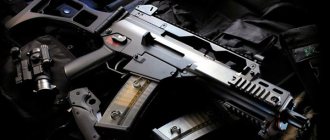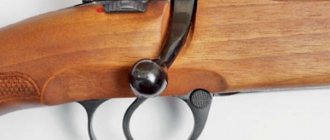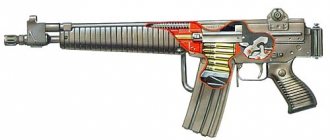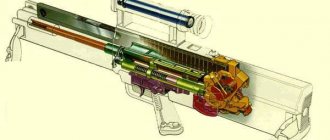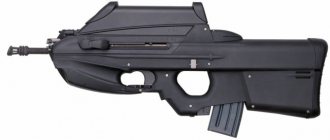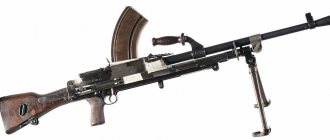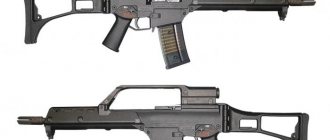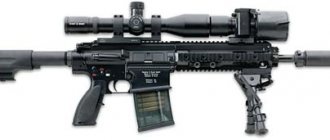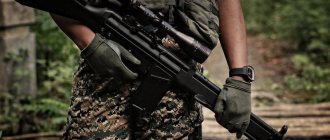Assault rifle (automatic) GIAT FAMAS F1 / G1 / G2
| FAMAS F1 |
In 1967, the designers of the French arsenal in Saint-Etienne “MAS” - Paul Tellier and Alain Coubet began developing a new French assault rifle that would meet modern standards.
FAMAS F1
In the new weapon, it was decided to use “low-pulse” 5.56 mm caliber cartridges and the choice was made in favor of the Remington 5.56x45 mm M193 cartridge.
The first prototypes of the new rifle appeared by 1971, and from 1972 to 1976 they underwent military tests in the French army.
The new weapon was found suitable for military use, and after eliminating some shortcomings it was adopted by France under the designation FAMAS (Fusil d'Assaut de la Manufacture d'Armes de St-Etienne - assault rifle of the arms factory in Saint-Etienne) in option F1.
The FAMAS F1 rifle became one of the world's first bullpup weapons adopted for service.
The first to receive the new rifle were soldiers of the airborne troops in 1978, and by the beginning of 1984, almost all advanced units of the French army were armed with 5.56 mm FAMAS F1 rifles. By that time, more than 300,000 units of these weapons had been supplied to the French armed forces.
| FAMAS F1 |
The FAMAS F1 rifle has a bullpup configuration (the magazine and chamber are located behind the trigger and pistol grip fire control).
The FAMAS F1 automation is based on the recoil of the semi-free shutter. The bolt is mounted in the bolt carrier and has a hole drilled to accommodate the firing pin, deflector pin, and spring. An ejector with a plug is installed on the detachable front part of the bolt. There are grooves on the rear lower part of the bolt frame that allow it to slide inside the receiver. A hole is drilled in the front part for a cylinder with a return spring, which is secured with a transverse pin. The deceleration lever has two parallel curved arms connected by a cross member. The shoulders connect the bolt to the bolt carrier, and the crossbar controls the position of the firing pin. The lower ends of the arms rest against a steel rod mounted across the receiver, and the upper ends rest against the end of the bolt frame. In this way, the bolt is held in the forward position with high chamber pressure, and energy is transferred to the bolt carrier. In addition, the trigger mechanism is controlled through the self-timer sear.
FAMAS F1 incomplete disassembly
The FAMAS F1 eliminates the drawback associated with the ejection of spent cartridges in both directions, which is present in many rifles built in the bullpup layout. This became possible due to the fact that the ejector mounted on the shutter mirror has two positions. The basic version of the rifle has a right-hand ejector, therefore, the cartridges are reflected to the right. Setting the ejector to a different position ensures that the spent cartridges are reflected to the left, while it is necessary to move the cheek rest to the other side of the butt and, thus, close the corresponding window for ejecting the cartridges.
The cocking handle is located on top of the receiver and is convenient for use with both hands.
When in use, the cocking handle is moved to the rearmost position and then released. It returns forward under the action of the return spring, while the bolt sends the cartridge into the chamber. When the bolt stops, the bolt carrier rests on the top of the retard lever, turning it forward. The lower end of the left arm of the retardation lever presses on a spring-loaded rod, which releases the safety sear. At the same time, the crossbar connecting the two arms emerges from a cutout in the firing pin, which is released and can move forward when the hammer hits it. When the trigger is pulled, the hammer moves forward and strikes the firing pin. The firing pin, in turn, passes between the arms of the deceleration lever and breaks the cartridge primer. Under the influence of recoil, the bolt begins to move away, turning the deceleration lever. The lower ends of the deceleration lever arms are located below the trunnion installed in the receiver, and the upper ends rest against the bolt frame. Since the upper parts of the arms are longer than the lower ones, according to the rule of leverage, the bolt carrier moves back much faster than the bolt. When the deceleration lever is turned back by 45 degrees, the bolt frame moves backward with acceleration, the crossbar of the deceleration lever enters the cutout in the firing pin and returns it to the bolt. The lower end of the left arm of the retardation lever extends from a rod leading to the safety sear, which is released so that the hammer is held in the rear position regardless of the position of the trigger and sear. The recoil of the bolt is delayed, which prevents the cartridge case from leaving the chamber while the pressure remains high. When the retard lever is rotated 45 degrees, the residual pressure in the chamber will push the cartridge out and throw the bolt back. Then the bolt and bolt frame move further, and the piston compresses the return spring in the cylinder. The cartridge case is thrown out through the window in the direction opposite to the “cheek”. The bolt carrier hits the shock absorber and compresses it by 25 mm. Then it, together with the bolt, returns forward under the action of the return spring. The cycle repeats.
The FAMAS F1 receiver is quite compact; most of the parts of the weapon body, including the forend, butt, trigger housing and carrying handle, are made of plastic.
FAMAS F1 with an installed 40-mm underbarrel grenade launcher.
The trigger mechanism is enclosed in a plastic case, which is attached to the receiver. It provides single and continuous fire, as well as fire in bursts of three shots. For this purpose, the mechanism is equipped with two switches: the usual fire mode switch with the “safety”, “single fire” and “continuous fire” positions is located next to the trigger, and the switch for firing in fixed bursts is installed under the trigger mechanism. Damage or failure of this switch will not affect the main fire modes in any way, since it is located separately from the mechanism itself. The following positions of the translator and switch correspond to different types of fire. Single light: translator “I”, switch - “0”. Continuous fire: translator "R", switch - "0". Fixed queue: interpreter - “3”. When the translator is installed in the “S” position parallel to the axis of the barrel, this means that the weapon is on safety.
Since the rifle is made according to the “bullpup” design, the trigger is located much ahead of the striker and is connected to it by a long rod. When you press the trigger, the pull moves forward. When the fire selector is set to the “single fire” position, forward movement of the rod is limited. There is a bushing on the rod that turns the trigger sear and disengages it from the trigger. If the deceleration lever is in a vertical position, the spring-loaded rod raises the self-timer sear. The trigger is released and a shot occurs. After this, the trigger turns back under the action of the bolt frame. The third sear, under the action of a spring, engages with the trigger and holds it. When the trigger is released, the bushing on the connecting rod returns back. Since the force of the trigger spring is greater than the force of the third sear spring, the trigger is held by the trigger sear. When you press the trigger, another shot is fired. When the fire type selector is set to the “continuous fire” position, the connecting rod travels forward a greater distance. The trigger sear disengages from the trigger. As a result of the bushing traveling a greater distance, the third sear is held in the rear position and the trigger is held by the self-timer sear. When the deceleration lever reaches the vertical position, it releases the self-timer and the shot occurs. Thus, continuous fire is controlled only by the self-timer sear.
The trigger guard can be pulled down and rotated 180 degrees for shooting with winter gloves.
FAMAS F1 with a rifle grenade on the barrel
The FAMAS F1 barrel is made of steel and has a corrugated surface. The fins serve not so much for its cooling as for firing rifle grenades. The mounting sleeve regulates the position of the grenade, which determines the flight speed and firing range.
There is a flash suppressor on the muzzle of the barrel. The flash hider can be used to throw rifle grenades straight from the barrel.
The weapon is fed from magazines with a capacity of 25 rounds. The magazine is attached to the rifle by turning it backwards until it is placed on the magazine latch. There are holes in the walls of the magazine indicating the presence of 5, 10, 15, 20 or 25 rounds.
| FAMAS F1 | FAMAS G2 | |
| Caliber, mm | 5.56×45 NATO | |
| Length, mm | 757 | |
| Barrel length, mm | 488 | |
| Weight without cartridges, kg | 3.6 | 3.8 |
| Store, count. cartridges | 25 | 30 |
| Initial bullet speed, m/s | 960 | 925 |
| Effective firing range, m | 300 | 450 |
| Rate of fire, rds/min | 900 — 1000 | 1000 — 1100 |
Sights are mounted on a long handle for carrying. The front sight is mounted on a leaf spring and can be moved using a knurled screw. Each notch corresponds to a 4 cm shift in the midpoint of impact at a distance of 200 m (0.002). The front sight is coated with a luminescent compound to ensure shooting at night. A removable open sight is used to fire anti-tank and anti-personnel grenades at direct fire. The sight consists of holes of two diameters. The diameter is selected using two hinged strips. One of them is installed on the front of the sight post and has a small hole for shooting in good light conditions, the other is installed on the end of the sight post and has a large hole for shooting in poor visibility conditions. At night, both slats fold down, and the top of the post forms a large hole, which is used in conjunction with the luminescent front sight. The sight is adjustable in the vertical plane. Its supports are raised or lowered by a screw that compresses a spring. One turn of the screw shifts the average point of impact by 7 cm at a distance of 200 m.
FAMAS F1 with a mortar muzzle attachment
The carrying handle is made of plastic. It provides protection for sighting devices from accidental damage. It also protects the recoil spring cylinder and covers the barrel, which gets very hot when fired. Sights are attached to the handle for firing grenades at an angle of 45 degrees or 75 degrees and for direct fire with grenades. It also has a folding lightweight bipod made of aluminum.
The forend has grooves for fingers.
There is a spring shock absorber in the upper part of the plastic butt. By absorbing the recoil force of the moving system, it compresses by 25 mm. To reduce recoil to the shoulder, a rubber butt pad is installed on the butt.
A container of gun oil is placed in the cavity of the pistol grip.
The bayonet is attached above the barrel.
To fire gas and other special grenades, the French police and gendarmerie use a 58-mm smoothbore mortar muzzle attachment.
In the early 1980s, modifications of the standard FAMAS assault rifle were developed:
— FAMAS Commando — an automatic carbine with a short barrel (405 mm), designed to arm special-purpose units. The shorter barrel of this modification eliminated the possibility of throwing rifle grenades. In all respects, this model is similar to the basic version and can fire in all modes. — FAMAS Export is a self-loading rifle, which can only be fired with single shots and whose design does not allow for firing rifle grenades. These weapons, as a commercial option, are intended for export to other countries. — FAMAS Civil — a self-loading rifle with an extended barrel (570 mm), the caliber of which was changed to chamber .222 Remington. The rifle is intended for commercial sale on the domestic arms market in France. This model only fires single fire and does not have the ability to fire a rifle grenade.
| FAMAS F1 sniper version |
A sniper version of the rifle was also proposed, in which, instead of the standard carrying handle, a guide for attaching an optical sight was installed.
In the early 1990s, the French arms concern GIAT Industries (manufacturer of FAMAS assault rifles) proposed an improved model of the rifle under the designation FAMAS G1.
In the new version of the rifle - FAMAS G1, the trigger guard has been changed, increased in size, and the forend has received a more convenient shape.
| FAMAS G1 |
After all NATO countries, including France, switched to standardized SS 109 cartridges of 5.56x45 mm caliber, a new model FAMAS G2 appeared in 1994.
The new rifle has become simpler and cheaper to manufacture. Replacing the cartridge used entailed replacing the magazine with a standard NATO magazine (M16 rifle magazine) with a capacity of 30 rounds. The pitch of the three right-hand rifling of the bore was changed from 305 mm to 228 mm, which made it possible to use both the M193 and SS 109 cartridges in 5.56x45 mm NATO caliber.
In 1995, the French Navy purchased the first batch of new FAMAS G2 rifles, and a little later the French Army began to receive them.
These rifles were also offered for export.
| FAMAS G2 |
Based on the basic design of the FAMAS G2 rifle, a number of modifications were created, including:
— FAMAS G2 Commando — a shortened version for special forces with a barrel length of 450 mm. — FAMAS G2 SMG — a submachine gun, an extremely shortened version of the FAMAS G2 with an even shorter barrel and forend. — FAMAS G2 Sniper — a sniper version of the FAMAS G2 with an extended barrel 650 mm long and an optical sight mounted on a Picatinny rail, replacing the standard carrying handle.
A FAMAS G2 variant was also offered with a standard Picatinny rail instead of a carrying handle.
| FAMAS G2 modifications |
FAMAS rifles are standardly equipped with a carrying belt and a bayonet; in addition, they can be equipped with a 40-mm M203 under-barrel grenade launcher (American-made - standardized for NATO).
FAMAS-FELIN prototype
The FAMAS family of rifles were used in various operations, including Desert Storm in 1991 and peacekeeping operations in the mid-to-late 1990s, where they proved to be reliable and convenient weapons.
In the late 1990s, the FELIN program was launched in France, designed to create a weapon system for the 21st century infantryman. As part of this program, a slightly modified FAMAS G2 rifle was equipped with various equipment, including electronic day and night sights, a laser range finder, weapon status sensors, as well as a data transmission system (including a picture from the sight) to the soldier’s helmet-mounted display and then to a wearable computer or up the chain of command.
In addition to France, FAMAS assault rifles were adopted by some former French colonies - Gabon, Djibouti, Senegal, the United Arab Emirates, as well as a number of other countries, such as Cambodia, Chad, Kuwait, the Philippines, and Sri Lanka.
| FAMAS-FELIN prototype |
Service [edit]
Improved FAMAS F1 Felin system
FAMAS first saw action in Chad during Operation Manta and then again in desert operations during Operation Desert Storm and various other peacekeeping missions. [11] Officially, operating conditions proved the weapon's reliability and reliability in combat conditions. FAMAS is affectionately known by French-speaking troops as le Clairon
("Burn") because of its shape. [2] An improved version of FAMAS F1 is integrated into the Félin system.
Senegal and the United Arab Emirates received a small number of FAMAS F1 rifles from France, [ citation needed
], although it is unknown when they received them. Djibouti uses this weapon in its military and gendarmerie[12] as a standard infantry weapon. The Philippines also received a limited number and is used by the Philippine National Police Special Action Force. [13]
Conflicts[edit]
FAMAS has been used in the following conflicts:
- 1982 Lebanon War [14]
- Chadian-Libyan conflict [14]
- Hostage taking in Uvea Cave [15]
- Gulf War [16]
- Civil war in Rwanda [17]
- Bosnian War [18]
- War in Afghanistan (2001–present) [19]
- Operation Unicorn [19]
- Iraq War [20]
- Operation Serval [21]
- Operation Barkhane [22]
- Syrian Civil War [23]
- Iraqi Civil War (2014–2017)
Users[edit]
FAMAS F1 is used by the Serbian police special forces.
- Cameroon [31]
- Central African Republic [32]
- Chad: presidential guard [33] and army [34]
- Djibouti [35]
- France: Used by the French armed forces since 1979, with over 700,000 rifles purchased. [16] Began to be replaced by the Heckler & Koch HK416 starting in 2022. [36] Also used by several law enforcement agencies. [16]
- Gabon. [37]
- Indonesia: Tactical diving group Komando Pasukan Katak
(KOPASKA) and special forces group
Komando Pasukan Khusus
(Kopassus). [38] - Iraq: Iraqi insurgents [39]
- Ivory Coast: [40] Alassane Ouattara's FRCI reportedly received some FAMAS in 2011, [41] but this claim is disputed. [42]
- Kanakas and the Socialist National Liberation Front [15]
- Lebanon [35]
- Papua New Guinea [43] [44]
- Senegal [45]
- Serbia: Used by SAJ.
- Syria: Several FAMAS F1s are used by loyalist militias, Jamaat Jund al-Kavkaz, Islamic State and Kurds [23]
- Thailand: FAMAS F1 used by the Royal Thai Army [46] [47]
- United Arab Emirates [14]
- Vanuatu [48]
Sources and links [edit]
- ^ ab "Modern Firearms - FAMAS". World.guns.ru. January 24, 2011. Archived August 26, 2010. Retrieved May 30, 2011.
- ^ a b Eger, Chris. "FAMAS BULLPUP ASSAULT RIFLES: LE 'BUGLE' (VIDEO)". Guns.com
. - https://talks.guns.ru/forums/icons/forum_pictures/004217/4217682.jpg
- "French MAS Type 1955". Forgotten weapons. Archived from the original on June 17, 2011. Retrieved May 30, 2011.
- "French MAS Type 62". Forgotten weapons. Archived from the original on June 17, 2011. Retrieved May 30, 2011.
- "FA-MAS Type 62". Securityarms.com. Archived from the original on July 16, 2011. Retrieved May 30, 2011.
- Morgan, Martin. "Classic Guns: The French FAMAS Bullpup Rifle". Illustrated shooting
. - Optical sight SCROME J4 F1 for FAMAS and MINIMI
- ^ abcde "L'armée rencontre de sérieuses difficulties avec les munitions du fusil famas". Archived from the original on January 11, 2015. Retrieved June 3, 2022.
- ^ abcd Hogg, Ian W.; Weeks, John S. (2000). Military small arms of the twentieth century
(7th ed.). Krause Publications. pp. 238–239. ISBN 978-0873418249. - "Meet Heckler and Koch's HK416: The Rifle You Need to Know About". National interest
. - "Archival copy". Archived from the original on January 11, 2022. Retrieved 11 January 2022.CS1 maint: archived copy as title (link)
- "Famas F-1". Rifles and pistols. January 2, 2007 Archived from the original on February 22, 2007. Retrieved December 10, 2008.
- ^ abc Bishop, Chris. Weapons in battle
. Chartwell Books, Inc. (1998). ISBN 0-7858-0844-2. - ^ a b Jean-Paul, Marie. "Nouvelle-Calédonie: la tragedie d'Ouvéa". Le Nouvel Observateur
(in French). Archived from the original on September 1, 2018. Retrieved August 31, 2022 - via grands-reporters.com. - ^ abc Markington, James (2004). Encyclopedia of Hand Weapons
. Lewis International, Inc. ISBN 1-930983-14-X - "Arming Rwanda: Arms Trade and Human Rights Abuses in the Rwandan War" (PDF). Human Rights Watch Weapons Project
. Vol. 6 pcs. 1. January 1994. p. 24. Archived March 18, 2016 (PDF). Retrieved December 7, 2022. - Edinger, B. (25 May 2012). "27 May 1995: les marsouins reprennent le pont de Vrbanja...". defense.gouv.fr
(in French). Archived from the original on September 2, 2022. Retrieved August 31, 2022. - ^ ab Richard, Christophe (Spring 2014). "Firing from the 'Steel Battalion'" (PDF). Fantassins
. No. 32. p. 28. Archived from the original (PDF) on December 15, 2018. Retrieved December 12, 2022. - "Why France Loves the Heckler & Koch HK416 Rifle". National interest
. - Jump up
↑ Capdeville, Thibault (Spring 2014).
"Firing of infantry units during OP Serval" (PDF). Fantassins
. No. 32. pp. 55–58. Archived from the original (PDF) on December 15, 2018. Retrieved December 12, 2022. - "Protests against French troops in Mali turn deadly - France 24". April 18, 2016. Archived from the original on July 11, 2016. Retrieved July 16, 2016.
- ^ ab "Des Famas en Syrie, preuve que la France arme les islamistes?" . France-Soir
(in French). August 30, 2022. Archived September 12, 2018. Retrieved September 12, 2022. - France launches tender to replace FAMAS. Archived May 24, 2014, on the Wayback Machine - IHS Jane's Defense Weekly, May 22, 2014.
- "France launches program to replace FAMAS rifle - Firearms Blog". Firearms Blog
. Archived from the original on July 17, 2015. Retrieved January 30, 2016. - "BREAK: Next French Infantry Rifle Is German - Heckler & Koch Reportedly WINS French AIF Rifle Competition - Firearms Blog". August 30, 2016. Archived from the original on September 13, 2016. Retrieved September 10, 2016.
- ^ ab https://www.janes.com/article/64230/french-army-selects-hk416-to-replace-famas Archived October 3, 2016 at the Wayback Machine The French Army selects the HK416 to replace the FAMAS. Nicholas de Larrinaga. London. IHS Jane's Defense Weekly. September 30, 2016
- "Archival copy". Archived from the original on October 14, 2016. Retrieved October 13 +2016 .CS1 maint: archived copy as title (link)
- VIOLATION: Heckler & Koch CONFIRMED as winner of the French contract for the AIF rifle; FN is appealing the French decision. Archived September 18, 2016, at the Wayback Machine - Thefirearmblog.com, September 14, 2016
- "Archival copy". Archived from the original on October 12, 2017. Retrieved October 12, 2022.CS1 maint: archived copy as title (link)
- "Des militaires camerounais arrêtés au Tchad". BBC News
(in French). May 9, 2022. Archived September 12, 2022. Retrieved September 12, 2022. - Berman, Eric G.; Lombard, Louise N. (December 2008). Central African Republic and Small Arms: A Regional Tinderbox (PDF). Small Arms Review. pp. 82, 94. ISBN 978-2-8288-0103-8. Archived from the original on January 7, 2022 (PDF). Retrieved September 4, 2022.
- "L'opposant tchadien Saleh toujours porté disparu". France 24. March 18, 2008. Archived October 16, 2022. Retrieved October 16, 2022.
- "Tchad: Instruction de 70 élèves-Officiers tchadiens au combat d'infanterie". ecpad.fr
. French Ministry of Defense. March 30, 2015. Archived October 16, 2022. Retrieved October 16, 2022. - ^ab Jones,
Richard D.
Infantry Arms 2009/2010
. Jane Information Group; 35th edition (January 27, 2009). ISBN 978-0-7106-2869-5. - Mizokami, Kyle. "How the FAMAS rifle changed the game for the French military". National interest
. - ↑
Kemp, Ian (April–May 2007).
"Assault Rifles in the 5.56mm Evolution: Introduction of New Designs and Modernization of Existing Weapons Ensures 5.56mm Remains the Predominant Assault Rifle Caliber". Armada International
. Archived from the original on September 12, 2022. Retrieved September 12, 2018. - "Kopassus & Kopaska - Specijalne Postrojbe Republike Indonezije" (in Croatian). Magazine Hrvatski Vojnik. Archived from the original on August 22, 2010. Retrieved June 12, 2010.
- Small Arms Review (2012). "Battlefield Research: Illegal Weapons in Afghanistan, Iraq and Somalia". 2012 Small Arms Review: Moving Targets. Cambridge University Press. pp. 320–321. ISBN 978-0-521-19714-4. Archived from the original (PDF) on August 31, 2022. Retrieved August 30, 2022.
- Anders, Holger (June 2014). Identifier of the sources of the statement: Les munitions de petit caliber en Côte d'Ivoire (PDF) (in French). Small Arms Review and United Nations Operation in Côte d'Ivoire. paragraph 15. ISBN 978-2-940-548-05-7. Archived (PDF) from the original on October 9, 2018. Retrieved September 5, 2022.
- Marot, Jean-Baptiste (7 April 2011). "Comment on pro-Ouattara forces preparing to attack Gbagbo". France 24. Archived from the original on September 7, 2022. Retrieved September 7, 2018.
- Jump up
↑ Duhem, Vincent (April 13, 2011).
"La France les deux pieds dans le plat ivoirien". Slate.fr
(in French). Archived from the original on November 24, 2022. Retrieved November 23, 2022. - "Geeks spot French rifles in PNG coup attempt". Keith Jackson and Friends: A RELATIONSHIP TO PNG
. Archived from the original on March 4, 2016. Retrieved February 29, 2012. - "PNG rebels trade weapons for amnesty". Australian
. January 31, 2012. Archived from the original on February 7, 2012. Retrieved February 29, 2012. - Binnie, Jeremy; de Cherisi, Erwan (2017). "African Armies of a New Model" (PDF). Jane. Archived from the original (PDF) on June 22, 2022.
- https://www.facebook.com/thailandlegion/photos/ ปืน -famas- ของ — ทบไทย / 1531098843586201 /
- https://pantip.com/topic/37166964
- "Vanuatu Daily Newspaper". modestclub.com
. Archived from the original on November 4, 2013.
Replacement [edit]
In 2022, the French armed forces began retiring the FAMAS in favor of the German-made HK 416 rifle.
When the Manufacture d'Armes de Saint-Etienne (MAS) factory closed in 2002, production of domestic rifles ceased. The last batch of newly produced FAMAS rifles, built in 2002, had served for over ten years by 2016. To date, the French armed forces currently use approximately 400,000 FAMAS F1 and G2 rifles, which are still stored in their arsenal. [24] The military also stopped producing special steel-cased ammunition for FAMAS. [9] Because the FAMAS did not function properly with standard brass-cased NATO cartridges (the chamber groove allows the F1 to use brass cases, but only the G2 rifles can use regular STANAG magazines), [9] and combined with concerns about the age of existing weapons, the French the military was looking for a replacement for the FAMAS rifle.
HK416N
In May 2014, the French Ministry of Defense issued a tender for the supply of a minimum of 90,000 rifles and carbines for the entire French armed forces. [25] In August 2016, the DoD selected the Heckler and Koch HK416 rifle to replace the FAMAS as the new general purpose service rifle. [26] [27] Under the French contract, the new rifle was designated HK416F, with the letter "F" denoting the French version. [28] 16,000 rifles would be purchased annually until a final quantity of 90,000 to 102,000 rifles was delivered. The new rifles are expected to remain in active French service for at least 30 years. [27] [29]FAMAS will be issued to the French National Guard and internal police units and will continue to serve in reserve and non-combat units until the phase-out of FAMAS occurs with the HK416. [thirty]
